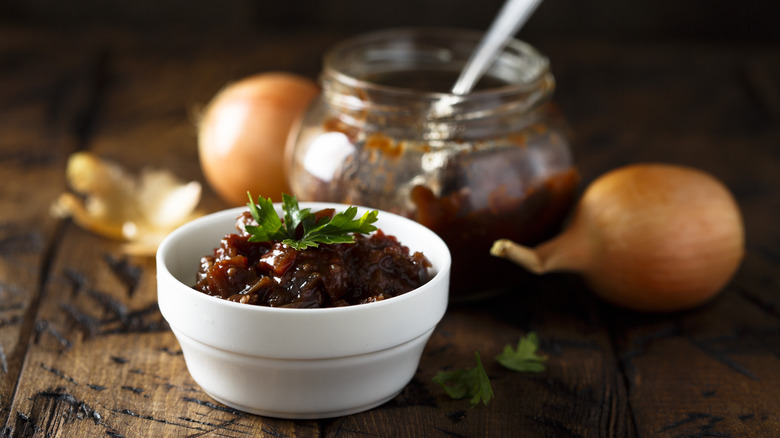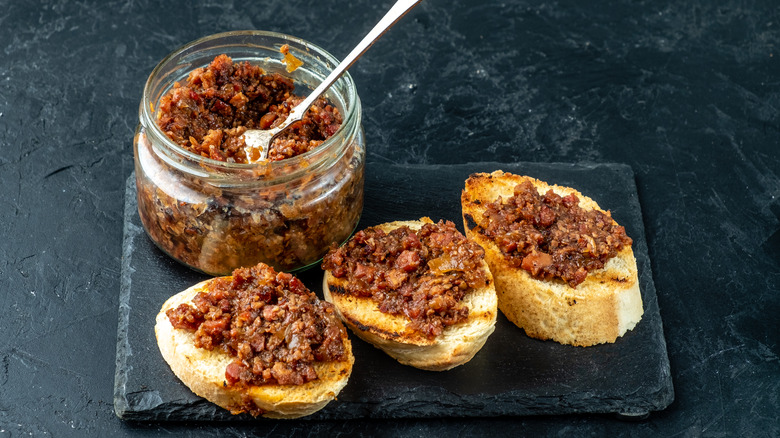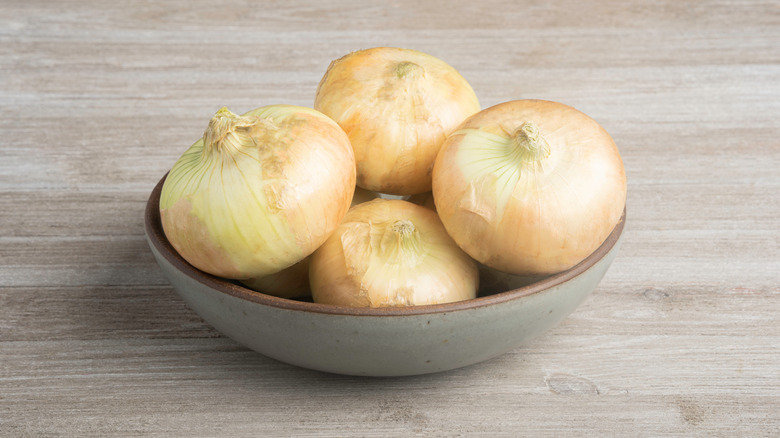What Are The Best Onions To Use For Home-Canned Onion Jam?
When you think of jam, you think of sweet fruits like berries, peaches, and apricots, but there's also a whole world of savory jams to discover. There's tomato jam, pepper jam, and even bacon jam, but the indisputable ruler of this savory kingdom is onion jam. Onion jam is made by caramelizing onions with a splash of vinegar, which adds a slight acidic kick and, more importantly, makes the onions extra soft so you can use them as a spread.
Onion jam is a popular charcuterie board condiment that pairs well with almost any meat and cheese dish. You can put onion jam on burgers, stir it into mac and cheese, and make the best grilled cheese you've ever tasted by pairing it with some gooey gruyere and crunchy French bread. Once you get hooked on this stuff, you'll use it every chance you get, and you'll want to keep some on hand at all times.
Onion jam is a bit laborious to make, as properly caramelizing onions takes around an hour (and sometimes more), but if you make a big batch and can or jar it for preservation, you can keep yourself supplied for months. But before undertaking such a task, you need to decide which type of onion to use. While you can technically make jam from any variety of onion, sweet onions are going to be your best bet. You might think this is because they contain more sugar than other types, but that's not exactly why.
Why sweet onions are perfect for onion jam
Sweet onions come in a few varieties, which we'll cover in detail momentarily, but they typically have pale yellow skin and white flesh. They look similar to yellow onions but differ in one very important way. Sweet onions stand out from other onion varieties (which can be grouped under the umbrella term "pungent onions") because of their sulfur content. Onions tend to absorb a lot of sulfur from the soil they grow in, and while this is important for the onion's growth, it also has some less-than-desirable effects. Sulfur compounds are why cutting onions brings tears to your eyes, and they also cause bitter pungency to onions.
Sweet onions have lower levels of sulfur than pungent onions, which gives them a milder, less "onion-y" flavor. This makes them seem sweeter, even though some pungent onions have lower sugar levels than sweet ones. Making onion jam using pungent onions, such as red or white, will have a bitter edge, which some people may enjoy. You especially need to look out for yellow onions. As previously mentioned, they closely resemble many of the most popular types of sweet onion, but they have the highest sulfur content of any onion variety, which could make your onion jam overpowering.
The best types of sweet onion
There are many types of sweet onions with different peak seasons. We will break down three of the most popular varieties, starting with the famous Vidalia. These onions were named after the town of Vidalia, Georgia. According to Georgia's Vidalia Onion Act of 1986, they can only be grown within a 20-county region of the state. You can identify Vidalia onions by their slightly flattened shape and the product lookup code on their stickers, which is 4159. Vidalias have the lowest sulfur levels and highest sugar content of any sweet onion. They are available from April to September.
Maui onions are the most visually identifiable sweet onion, with an oblong, football shape. They are one of the rarer onion varieties, as they are only grown within a 400-acre region on the slopes of the dormant Haleakala volcano on Maui. You can verify it's a real Maui onion by looking for the label "Kula Grown" and the product lookup code 4164. Maui onions are available year-round, but their peak season runs from spring through early summer.
Finally, let's talk about Walla Walla onions. They, too, are only grown in a limited region, this time in the Walla Walla Valley of Washington state. However, they originated from seeds brought to the U.S. from Corsica, Italy. Walla Walla onions look like medium-sized yellow onions with very thin rings. You can find them from summer through early fall with the product lookup code 4163.


